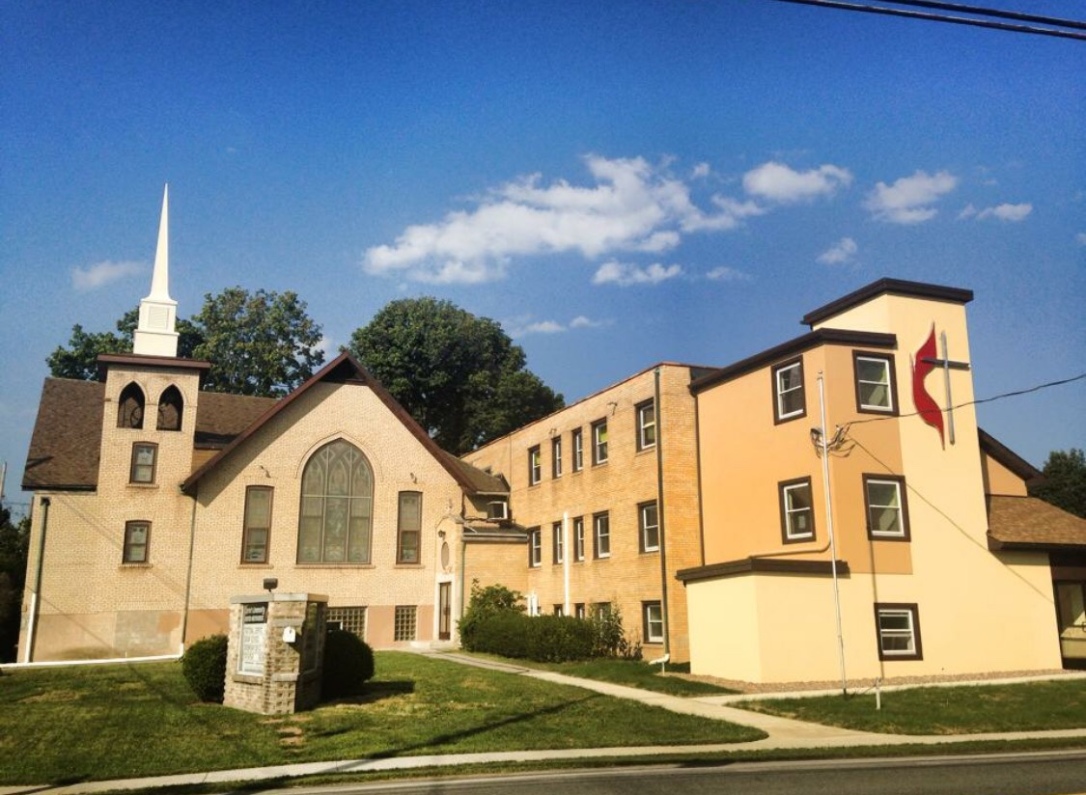Dear Friends,
It’s that time of year again! Easter will soon be upon us and that means that many of our churches will (hopefully) be having many visitors! No matter what time of year it is, it is my hope that we will do our best to make our worship services and church buildings as accessible as possible. My dream for the church is that we will become an inclusive place where all are invited to join with us in worship!
In order to help my dream to come true, I have complied a list of relatively easy accommodations that most churches can make in order to be more accessible and inclusive.

1. The single and most important fact is that accessibility begins in the heart of the pastor and the congregation.
As a person who has low vision, I would happily worship in a church with absolutely no accommodations as long as the congregation made me feel welcome. In contrast, I would not worship at a church where I was made to feel unwelcome, even if that church had all the accommodations in the world.
I grew up in a small church and the only accommodation available was a large print hymnal. I still love that church very much and return to visit whenever I can because they made me feel like part of the family. I knew that I belonged at that church.
2. Accessibility doesn’t have to be expensive.
Remember: It doesn’t cost a penny to make someone feel welcome. People can sense when they are wanted; conversely, people can sense when they are being starred at or watched incredulously.
The church that I serve church received a generous gift in memory of a wonderful woman named Gloria Brown. This gift allowed us to renovate our church building in order to become more accessible. In 2015, we added an elevator and a handicapped accessible restroom. These renovations were very expensive and cost our congregation over $120,000. We would not have been able to complete them without such a generous gift; however, it does not take a great deal of money to make a church truly accessible. It simply takes open hearts and open minds.
(Pastors: This is also an effective illustration of why it is important to encourage parishioners to remember the church in their will. For more information about estate planning, I recommend contacting Rev. Phyllis Bowers from the United Methodist Stewardship Foundation).
3. Please do not stare, whisper, or make assumptions about people with disabilities.
I am a member of the National Federation of the Blind. I also have many friends who are blind, visually impaired, or have another disability. I asked Quinn Haberl, a young professional who was raised in a Christian home, why he no longer attends church. Quinn responded:
“Although I was raised in the church, I no longer attend because I haven’t been able to find a church where my fiance and I feel comfortable. We are both blind and every time we walk into a church people assume that we are looking for charity or some type of hand out. They want to pray for us because we are blind. I can tell that they don’t realize that we are both young professionals. You can pray for us, but don’t assume that we need prayer because we are blind. I am blind and happy. “
-Quinn Haberl
4. Technology is the way of the future.
Technology can do amazing things. There are countless applications and computer programs available to make the world accessible for people with disabilities. Every iPhone and Apple Product comes fully equipped with low vision and voice over features.
For example, the KNFB reader can take a photo of any object that has printed words and convert that image into large print or read the text aloud. (Note: This application only works in situations with good lighting so it is not ideal for use in a sanctuary).
There are applications and programs that do more than you could possibly imagine. There are even applications that allow users who are blind to link up with volunteers who will “be their eyes” in order to help to navigate tasks like using a washing machine or microwave.
In short, if you see someone using their phone or a laptop in church, don’t assume that person isn’t paying attention. He could be reading the Bible or following the Order of Worship!
5. Make any and all printed materials available online.
As I said, technology is the way of the future. It costs nothing to e-mail documents to parishioners or church people ahead of time. Information can also be posted to the church website.
Information that is available digitally can be enlarged on a screen. It can also be read by a person who is using a braille computer or braille display. People who read braille usually use a computer with a braille display, such as a Braille Lite or Braille Note, to read books, websites, or documents.
In our current technological age, I know many people (not just people who are blind) who would prefer a digital order of worship.
Please note: Not all PDFs are automatically accessible. If you create a PDF, make certain that you that you save it so that the text is set to OCR- Optimized Character Recognition
6. If your church has a website, do these two small things to increase it’s accessibility.
Technology is the great equalizer. It can also be incredibly frustrating. I know it can be challenging for churches to cultivate an online presence in the first place, but even if you are not a master of web design, here are two simple things that you can do to make your website accessible:
- If your website includes images, make certain to include “alt text.” Alt Text is read aloud by a screen reader.
- Always include a search box. Search boxes are of the utmost importance for people who are blind or who have low vision.
There are also companies available who will test websites for churches and small businesses and provide feedback about accessibility.
7. If your church has a microphone, please encourage everyone to use it when they are speaking. Also, consider installing a “Hearing Loop.”
The majority of disabilities are invisible. For example, you cannot tell by simply looking at a person if that person has poor hearing, autism spectrum disorder, or chronic pain. You never know who is sitting in the pews so it is important to always use a microphone.
On their own, microphones do not solve the issue of accessibility for people who have hearing loss; however, a microphone can be connected to a “hearing loop” or other assistive hearing system. (For more about hearing loops, please refer to this article by Rev. M. Dyer, “Please Hear Those of Us Who Can’t.”)
I realize that this is often an uphill battle. I want to encourage church people to be involved in worship; however, many people are terrified of public speaking and clam up as soon as you hand them a microphone. Therefore, I try to start with the children. I encourage them to speak into the microphone during my children’s message and many of the kids think that this is great fun.
For the adults, I simply try to emphasize the fact that this is an accessibility issue and we want everyone to be included in worship
8. Make parents and families of people with special needs feel comfortable in worship.
Once more, please do not stare. If a child is loud or rambunctious in church, please do not assume that the parents are not good care givers. Many children also have invisible disabilities such as autism.
It often takes a great deal of bravery for parents with children who have an invisible disability to attend worship. Many families feel isolated and alone as it is. The church should be a place where they feel welcome and included.

9. Have large print hymnals and bulletins available.
Make sure that there are always at least three large print hymnals and three large print copies of the order of worship available. If there is only one large print hymnal, people will not take it because they are afraid of taking from someone who might “need it more.”
This could also be helpful for people who are dyslexic. Make certain to use a font size that is at least fourteen points. Arial is also considered “easy to read” for people who have low vision or who are dyslexic because it has wider spacing and the letters are less stylized than in Times New Roman.
Consider purchasing a braille Bible for your church. Although, please know that nowadays most people who read braille do so with a braille computer. This means that they probably have their own Bible already accessible on their handy piece of technology.
10. Announce what accommodations are available.
If there are large print hymnals or if your order of worship is available online, make that announcement at the beginning of worship and let people know. Remember- a person who is blind won’t be able to read announcements in a printed bulletin or on a screen.
Some churches provide a gluten free communion option. Other churches have assistive hearing devices available. Let people know what options your church has to offer.
11. If you use a slideshow, please make the slides available online.
Remember: Technology is the way of the future and not everyone can see a screen.
If you use visual aides to illustrate your sermon, describe them to the congregation. For example, last Sunday I said, “Zephaniah was one of the minor prophets. On the screen, you can see an image of an icon representing Zephaniah. Doesn’t he look like a cheery fellow?”
12. Announce where the bathrooms are located.
This is simply a hospitality issue. Everyone wants to know where the bathroom facilities are located.
13. Have greeters and ushers available at every door.
If your church is anything like mine, it has way too many doors. Have a greeter available at every entrance (especially on Christmas or Easter) to direct people to the sanctuary.
14. Ask before you grab.
Please teach your greeters and your parishioners NOT to touch someone without first asking.
DO NOT:
–Grab a person who is blind and drag him to a pew
–Pet a guide dog without first asking permission. Guide dogs are working animals!
–Touch a person’s wheelchair without first asking. Personal autonomy is important!
–Hug a person without asking. Many people have ASD or PTSD and they do NOT want to be touched. This is particularly important during the passing of the peace.

15. Use appropriate signs.
The layout of many church buildings can be incredibly confusing. Signs should have large clear letters. Ideally, signs should also include braille.
16. Use people first language.
People should be defined first and foremost by the fact that they are children of God and not by their disability. I know that this is challenging in English because we construct our sentences by placing the adjective before the noun; however, this is very important.
Be careful in your speaking and in your preaching. For example, it is best to say that Jesus healed a MAN who was born blind. He was a PERSON and a child of God above all else.
In conclusion, as our congregations continue to age, many more people will develop a disability such as low vision or hearing loss.
The majority of these accessibility options cost very little money. Elevators and handicapped accessible bathrooms are great, but true accessibility begins in the hearts of the people!
At my wedding, I had one of my best friends read scripture. She did an excellent job and she read from 1 Corinthians 13 in braille. After the service, someone told me, “Wow! I didn’t know blind people could read!”
Problematic assumptions and lack of awareness are systemic problems in our society. That is why I encourage church leaders to help to empower people with disabilities.
Furthermore, I encourage us to realize that people with disabilities can be effective leaders in the church. I believe that people with disabilities are an untapped resource for such a time as this. There are more of us in the pews than you may realize.
In the United States of America, the church is not required to comply with the American’s with Disabilities Act; nevertheless, we should make every effort to incorporate all people into the body of Christ.

If you would like to read more of writing about what it’s like to live in a world with low vision, CLICK HERE to check out a sermon I wrote entitled “What Does Healing Look Like?”
There are so many relatively easy ways to improve accessibility in the church that I couldn’t possibly begin to include them all in this article. What ways did I miss? Please let me know in the comments! In the future, I hope to write a follow up piece and will do my best to include your ideas. Thank you!
Further Resources:
-Dyer, M. (2013). “Please Hear Those of Us Who Can’t.” Sojourners. Retrieved from: https://sojo.net/articles/please-hear-those-us-who-cant
Dyer offers more information on hearing loops and assistive technology for people with hearing loss.
-“Resources.” (n.d.) The United Methodist DisAbilities Ministries Committee. Retrieved from: https://www.umdisabilityministries.org/resource.html
An extensive list of a variety of resources for churches and nonprofits regarding accessibility and access needs.
-The United Methodist Stewardship Foundation. https://www.umstewardship.org/
The United Methodist Stewardship Foundation (UMSF) is a great resource for churches and nonprofits who are in search of assistance for fundraising, financial stewardship, and estate planning.
Revised January 17, 2019



You have totally missed the most common disability of all, hearing loss, which affects one in five people. A mike simply is not enough. We have volume control. You need an assistive listening system, preferably a hearing loop, to help people with hearing loss hear more clearly.
Please educate yourself and about this and then amend this article. Youcan check out http://www.hasloops.com to learn about hearing loops, by far the best assistive listening system on the market.
I will not go to a church without one, because I need it. If you want more you can contact me at mary@journeyroad.org.
LikeLiked by 1 person
Thank you so much. I know very little about hearing loss and I will research this issue. Thank you for bringing it to my attention. I will add an update to this article and hopefully find out more information that I can share in a followup piece
LikeLike
It would be so helpful if some non-profit would provide advice to very tiny, historic churches. The congregation added onto our 100-year-old building in the 1960s (pre-ADA). The addition with restrooms was built 3 steps up from the sanctuary in order to make a basement fellowship hall possible. They built a ramp to the sanctuary, but there’s no way to get to the restrooms without steps. We have 20 active members, in a quickly-growing community, and can’t afford to install something to get past those stairs, let alone come up with a way it could be done. I’m sure it could be done, though. We’d just need professional advice and a construction grant.
LikeLiked by 1 person
We do one thing though: all our bulletins are large-print.
LikeLiked by 1 person
I think large print bulletins are wonderful 🙂
LikeLike
The United Methodist Disabilities Committee might be able to help. They consult with churches and you don’t have to be Methodist. You can contact them at https://www.umdisabilityministries.org
LikeLike
How about building a small addition with a bathroom at the right level? Just a toilet and sink.
LikeLike
Hearing loops: https://www.umdeaf.org/hoh/ — we also welcome additional information
LikeLiked by 1 person
Thank you! I will check this out 🙂
LikeLike
I think in just bringing up the points that you have opens up the conversations that should be had to include all people. Personally I suffer with chronic pain associated with back issues. Sitting in a pew can lead to a few low lying days trying to recover. Thus I have tried to catch sermons online but I miss the interactions of going to church. Thank you for this post and opening up the conversation that is a real issue that parishioners have.
LikeLiked by 1 person
Thank you for these thoughts! You raise a really good point about chronic pain. I know siting for extended periods of time, especially in a church pew, can be really problematic. Thanks for sharing 🙂
LikeLiked by 1 person
Thank you for this! One of the things I think is so hard for all churches financially (including mine) is to physically overhaul the buildings. I know it’s expensive but would’ve loved to take my grandmother to church her last year with us but couldn’t because there wasn’t a wheelchair accessible entrance/ramp. Thanks for writing this, makes me feel better knowing people are trying to address the issue.
LikeLike
Such a thoughtful post!
LikeLike
These are great suggestions! We have a couple of elderly congregation members who don’t get around as well. We now have a transport chair, and it’s been one of the best accommodations. Some of the men take the wheelchair to their cars and get them from the vehicle and deliver them to their pews.
LikeLike
Excellent post. Years ago, one of our friends in my church struggled with her vision. She had been finding it failing over the years and, as we struggled to learn how to love her through it, we started providing large print bulletins and so on. At the same time, I was working on getting a projector system installed in our church. I figured the projector was really more for updating and allowing more options in the service and so on—I had no idea the benefit it would be to her. After the projector was installed and the words for the music flashed up on the screen, our friend shared with us that she could finally read the words to the songs since they were lit up on the projector screen and she could finally sing again in the service after so many years. I was blown away. I just simply had missed the obvious of how a small change like that could open up the joy of singing praises in community again.
Learning to love one another by caring for each other through these areas is one of the areas that I think we easily miss. Thank you for drawing attention to it.
What I loved most about this, however, was this:
“As a person who has low vision, I would happily worship in a church with absolutely no accommodations as long as the congregation made me feel welcome.”
There’s no doubt about it. While all these accommodations are important and must be pursued, love is number one.
Thanks for a great post.
LikeLiked by 1 person
Thank you so much for your kind words! Hearing your story and hearing about your friend warms my heart. I truly believe that real inclusion starts with the heart. I hope you and yours have a very merry Christmas!
LikeLike
Merry Christmas to you too!
LikeLiked by 1 person
Hi! Thanks for writing this! A couple things. In your section about technology, can you put something in there about infographics? I find many churches are using these very frequently. Unfortunately, my church is infamous for using these in their emailed anouncements, their website, and on their social media pages. Which I guess brings me to another thing. Given that we’re in the age of social media, maybe something about making their social media accessible…again, infographics, mems, etc. And possibly how it feels from our standpoint when churches dismiss when we raise accessibility concerns. Again, take mine. The congregation itself makes me feel welcome, and they don’t treat me like a charity case. Yet, when accesibility is brought up, they make excuses of why they can’t. What that says to me is that I’m not welcome there, I’m not important, no matter if the actual congregation treats me like I am. When I hear Pastors stand up there and talk about how everyone is welcome, wanted, important, yet they dismiss when PWD raise concerns, it sends a completely opposite message, and therefore makes pastors and church staff look like hypocrites. Excuses I’ve gotten when I bring up the accessibility issues, particularly those about technology include: Lack of money, lack of staff to take the time to redesign things, lack of resources who are knowledgeable about such things. You mentioned there are small companies who do accessibility testing for churches and small organizations. I can tell my church that something is not accessible, but I’m not tech-savvy enough to give them solutions. Could you maybe list some in your follow-up article, or perhaps write a separate one about resources for churches that really do want to make themselves more accessible, but don’t know how? Thanks again for writing this!
LikeLiked by 1 person
You raise some really excellent points! In the past, I have also had my concerns dismissed and I know that it is hurtful. I’m sorry that you had that experience. That is why I want to be a positive voice for accessibility awareness.
I strongly dislike infographics. An easy way to make them more accessible (even if a church doesn’t have money) is to simply include a description of what the graphic says or how it appears in the body of the text. On my blog, I always try either put a description in the caption and/or use alt text. I’ve been looking into accessibility testing for my church’s website and it seems there are several options. There are companies a church can pay to actually redesign a website and make it accessible- but that can get really expensive really quickly. Quotes start at around $4500. A more affordable option is a class or webinar, where the people who make the church’s website can learn simple tricks (like how to use alt text) in order to make a website more accessible. I’m glad that you mentioned these issues. I will work to find out more about them (one of my friends actually works for a company that tests website accessibility) and I will include these issues in my followup piece. Thank you for reading and thank you for sharing your thoughts!
LikeLike
it was a good read. I feel that you actually made an effort to accumilate all the important points that can be considered by the church developers. ☺️👍
LikeLiked by 1 person
Thank you so much and thank you for reading 🙂
LikeLike